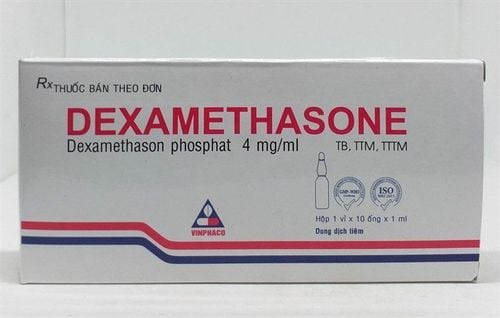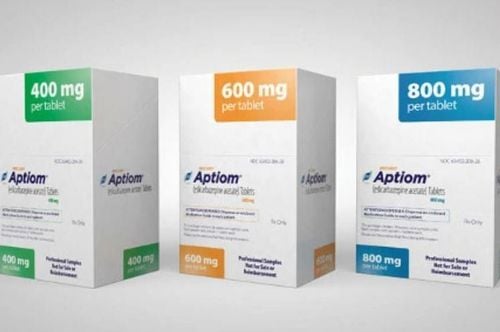This is an automatically translated article.
Fosphenytoin medicine contains the main ingredient Fosphenytoin, which is a hydantoin derivative anticonvulsant. The drug is prepared in the form of an injection with different concentrations of 50mg/ml; 75 mg/ml.1. Uses of Fosphenytoin
Fosphenytoin is a prodrug of phenytoin, the pharmacological action of which is due to phenytoin. The drug's mechanism of action may be due to voltage-dependent blockade of membrane sodium channels, resulting in a decrease in persistent high-frequency nerve discharge. Fosphenytoin may cause hypotension after intravenous administration.
Fosphenytoin is indicated in the following cases:
Epilepsy. Prevention and treatment of seizures that occur during neurosurgery or as a result of head trauma. Use as a temporary alternative to oral phenytoin. Fosphenytoin is contraindicated in the following cases:
People with a history of hypersensitivity to fosphenytoin or any component of the drug Fosphenytoin, hypersensitivity to phenytoin or other hydantoins. Sinus bradycardia. Second and third degree atrioventricular block. Adams-Stokes syndrome. History of acute hepatotoxicity with fosphenytoin or phenytoin. Concomitant use with delavirdine. Acute porphyria metabolic disease. Note when using Fosphenytoin:
Fosphenytoin can harm an unborn baby if used during pregnancy. In case of using Fosphenytoin for pregnant women, it is necessary to monitor the serum phenytoin concentration and adjust the drug dosage accordingly. It is not known at this time whether fosphenytoin passes into breast milk; however, phenytoin does pass into milk. The known benefits of breastfeeding should be weighed against the woman's clinical need for fosphenytoin and any potential adverse effects on the breastfed infant receiving the drug or underlying medical condition. mother's copy.
2. Dosage and how to use Fosphenytoin
Fosphenytoin is used by intramuscular injection or intravenous infusion, the dose is calculated according to the amount of phenytoin sodium (PE) with the ratio of 1.5mg fosphenytoin sodium will be equivalent to 1mg of phenytoin sodium and is called 1mg PE. The dose of Fosphenytoin should be according to the doctor's prescription.
Fosphenytoin dose for adults in specific cases as follows:
Treatment of epilepsy: Initial dose: 20mg PE/kg IV infusion at a rate of 100 - 150mg PE/min. Maintenance dose is 4-6mg PE/kg per day in 1-2 divided doses, intravenous infusion at a rate of 50-100mg PE/min, maximum 150mg PE/min. The dose is adjusted according to the patient's response and the phenytoin trough plasma concentration. Prevention and treatment of seizures during neurosurgery or head trauma: Initial dose: 10 - 20 mg PE/kg, intravenous infusion (at a rate of 50 - 100 mg PE/min, maximum 150 mg) PE/min) or intramuscularly. The maintenance dose is 4-6mg PE/kg per day in 1-2 divided intravenous doses at a rate of 50-100mg PE/min, up to a maximum of 150mg PE/min. The dose of Fosphenytoin is adjusted according to the patient's response and phenytoin trough plasma concentrations. Temporary alternative to oral phenytoin: Use fosphenytoin intramuscularly or intravenously at the same dose and frequency of administration as oral phenytoin therapy. Dosage of Fosphenytoin for children in specific cases is as follows:
Treatment of epilepsy: Initial dose: 15 - 20 mg PE/kg, intravenous infusion at a rate of 2 mg PE/kg/min or 150mg PE /min, whichever is slower. The maintenance dose is 2 - 4 mg PE/kg every 12 hours, administered intravenously at a rate of 1 - 2 mg PE/kg per minute (or 100 mg PE/min, whichever is slower). Initiate maintenance dose 12 hours after initial dose. Prevention and treatment of seizures during neurosurgery or head trauma: Initial dose is 10-15mg PE/kg, IV infusion at 1-2mg PE/kg/min (or 150mg) PE/min, whichever is slower). The maintenance dose is 2 - 4 mg PE/kg every 12 hours, intravenously at a rate of 1 - 2 mg PE/kg/min (or 100 mg PE/min, whichever is slower); Start the maintenance dose 12 hours after the initial dose. Temporary alternative to oral phenytoin: Use a dose equivalent to the oral dose. For the elderly, a 10-25% reduction in the dose of Fosphenytoin or a decrease in the infusion rate should be considered.
Symptoms that may be encountered with an overdose of fosphenytoin sodium include: Nausea, vomiting, tachycardia, bradycardia, asystole, cardiac arrest, coma, hypotension, syncope, hypocalcemia , metabolic acidosis and death.
There is no antidote for an overdose of fosphenytoin sodium or phenytoin. Respiratory and circulatory function should be assessed and appropriate supportive measures used. Hemodialysis may be considered because phenytoin is not fully bound to plasma proteins. Whole blood transfusion has been applied in the treatment of severe poisoning in children. In the event of an acute overdose, the possibility of inducing other CNS depressants, including alcohol, should be taken into account.
If you miss a dose of Fosphenytoin, call your doctor for instructions on what to do.
3. Fosphenytoin side effects
Common side effects of Fosphenytoin include:
Body weakness. Chills. Dizzy . Sleepy. Dry mouth . Digestive disorders. Excited mood. Headache. Low blood pressure. Movement disorder. Nausea, vomiting. Eyeball tremor. Unusual feeling. Skin reaction. Ecstatic. Taste change. Tinnitus . Vasodilation. Visual disturbances. Less common side effects of Fosphenytoin include:
Cardiac arrest. Confused. Deaf. Muscle weakness. Nervous. Oral disorders. Abnormal reflexes. Serious adverse skin reactions. Systemic lupus erythematosus. Unusual thinking. Adverse effects of undetermined frequency with Fosphenytoin include:
Acute psychosis. Loss of granulocytes. Appetite disorder. Decreased atrial conduction. Atrioventricular block. Bone disorders. Fracture. Bone marrow disorders. Slow heart rate. Cardiac toxicity. Cerebral vascular failure. Circulatory collapse (more common if the injection is given too quickly). Constipation. Delirium. Decrease in granulocytopenia. Tingling in the groin. Liver disorders. Increased blood sugar. Hypersensitive. Insomnia. Swollen lymph nodes. Polyarthritis. Respiratory disorder. Peripheral polyneuropathy. Decreased platelets. Convulsions. Ventricular fibrillation (more common if injected too rapidly). If you see any unusual symptoms while using Fosphenytoin, you should immediately notify your doctor for timely treatment.
4. Interaction of Fosphenytoin with other drugs
Drugs that may increase serum phenytoin concentrations when used with Fosphenytoin include: Antiepileptic drugs (felbamate, ethosuximide, oxcarbazepine, methsuximide, topiramate), antineoplastic agents (capecitabine, fluorouracil), antineoplastic agents. azole antifungals, antidepressants, stomach acid reducers (omeprazole, cimetidine), sulfonamides, acute alcohol abuse and others such as amiodarone, chloramphenicol, disulfiram, estrogen, fluvastatin, isoniazid, chlordiazepoxide, methylphenidate, phenothiazines, ticlopidine, tolbutamide, salicylates, trazodone, warfarin. Drugs that may decrease serum phenytoin levels when used with Fosphenytoin include: Anticancer drugs (bleomycin, cisplatin, doxorubicin, carboplatin, methotrexate), antiepileptic drugs (carbamazepine, vigabatrin), drugs antivirals, chronic alcohol abuse, diazepam, folic acid, Reserpine, diazoxide, rifampin, St. John's wort, theophylline. Drugs that may increase or decrease serum phenytoin concentrations when used with Fosphenytoin include: Phenobarbital, valproic acid, valproate sodium. Fosphenytoin reduces the effectiveness of the following drugs: Fluconazole, trinotecan, ketoconazole, posaconazole, itraconazole, voriconazole, paclitaxel, teniposide, neuromuscular blocking agents, delavirdine, warfarin... Fosphenytoin reduces the concentration of these drugs. the following medicines: Carbamazepine, felbamate, topiramate, lamotrigine, oxcarbazepine, fluvastatin, simvastatin, efavirenz, atorvastatin, lopinavir/ritonavir, indinavir, ritonavir, saquinavir, nifedipine, nelfinavir, nimodipine, verapamil, albendazole, nisolgodipine, chlorpropineamide, clozapine, disopyramide, folic acid, methadone, praziquantel, mexiletine, quetiapine.













